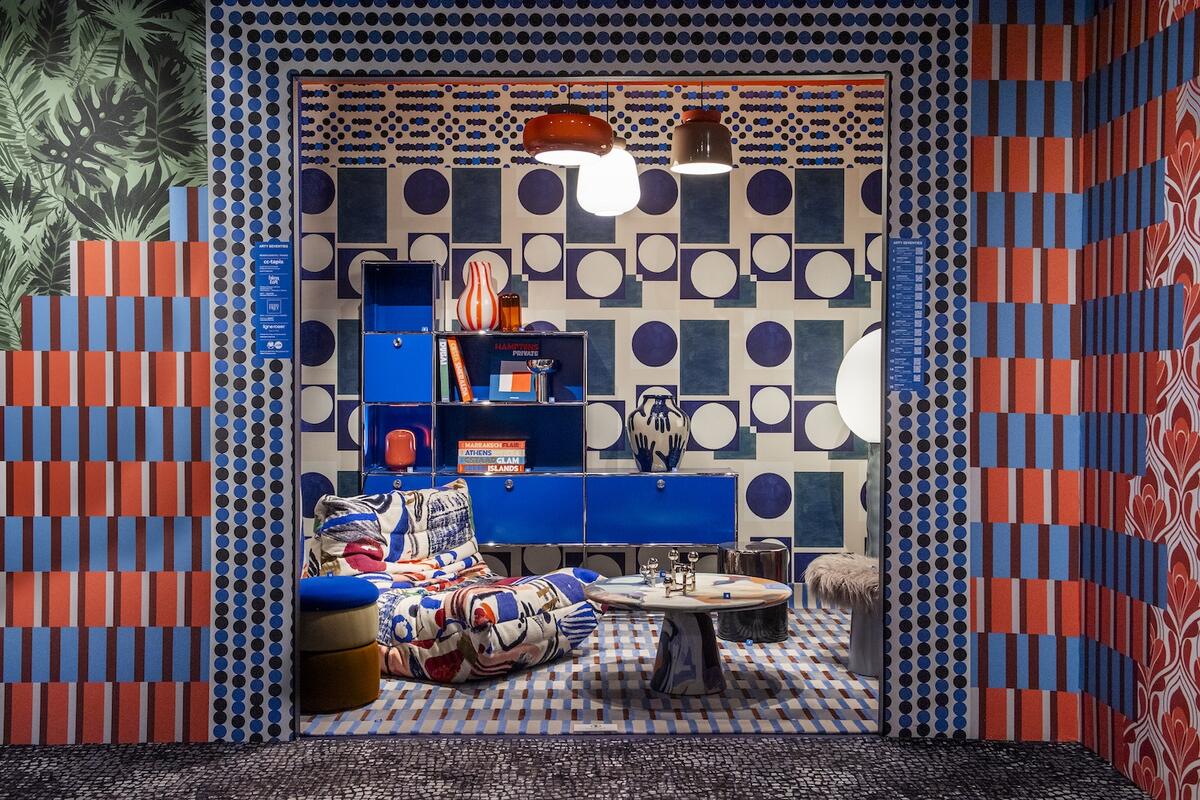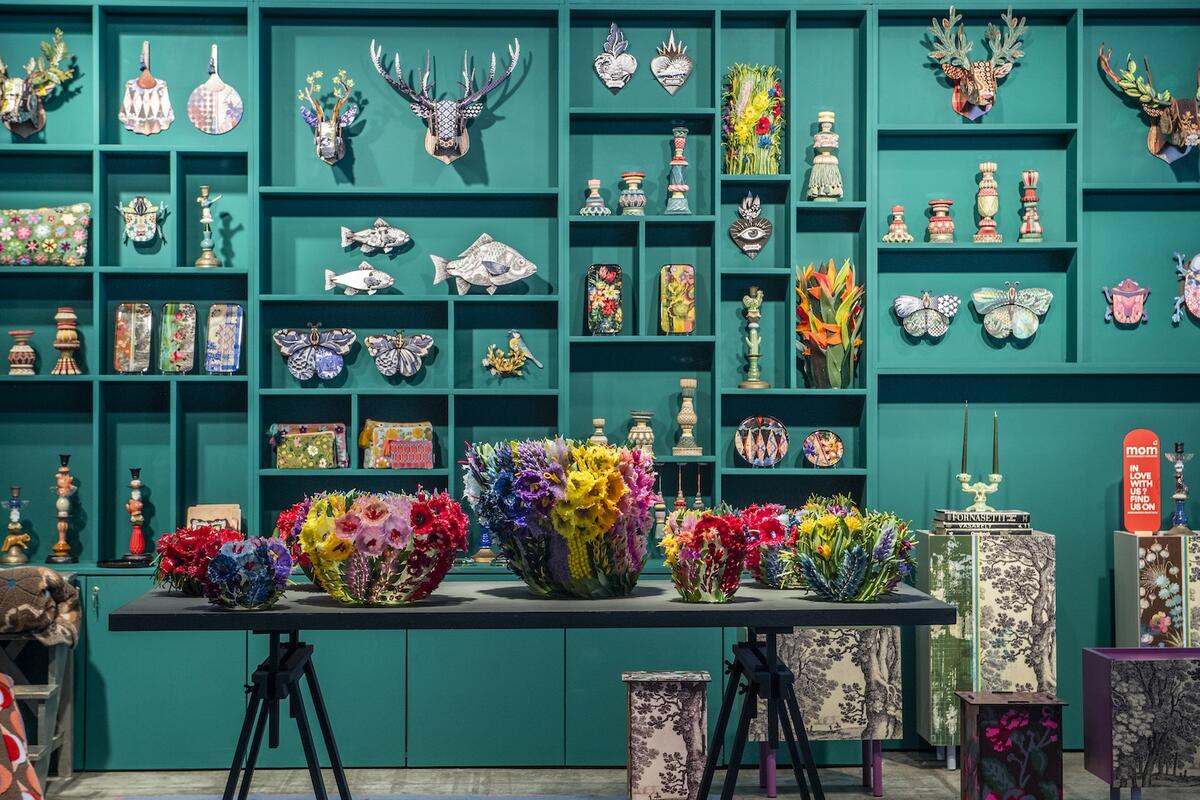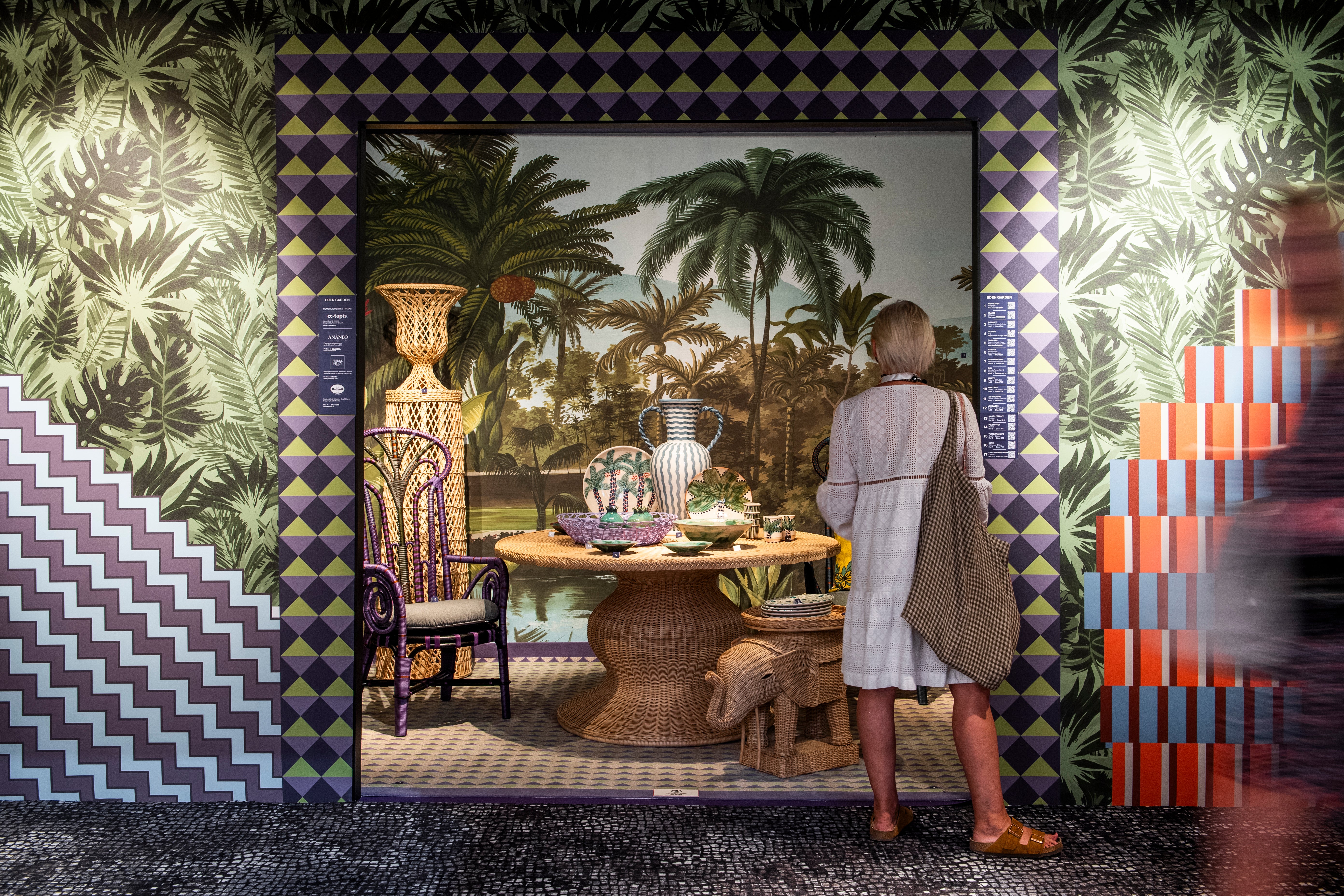In this day and age, it is a bold decision to decide—eight months ahead of time—that the theme of your trade show will be “Enjoy.” As the world seems to lurch from crisis to crisis, it’s not a given that attendees will be in any mood to cut loose and party.
But that was precisely the gamble made by the organizers of Maison&Objet, the twice-yearly French trade show held in the outskirts of Paris in Villepinte. This fall’s edition was billed as a “quest for pleasures”—an explicit rejection of the “austerity that brands and society” have bowed to in response to a war, a pandemic, a climate crisis—the list goes on. In short: Let’s find a way, amid it all, to have fun.
It’s a complicated needle to thread, one the show’s marketing director, Caroline Biros, was acutely aware of when I spoke with her near the start of the five-day show. “Life is short—we need to enjoy what we do, take pleasure and be happy,” she said. “‘Enjoy’ doesn’t mean being crazy. … it’s a mix of how you can be responsible about how you produce and how much you buy, but at the same time, have pleasure with joyful colors, optimism and a wonder for nature.”
The show, featuring more than 2,500 brands and 67,000 professional attendees this past weekend, largely delivered on the concept. The colors were upbeat, the design was inspiring, and the mood was good. If there was an impediment to the enjoyment, it was the temperature: A late-season heat wave had swept over the city, and the sound of attendees fanning themselves with their cardboard badges made for a persistent background flutter. That aside, everyone seemed in the spirit to try and shake the post-pandemic doldrums, buy, sell and have fun doing it.
Maison&Objet is like any American trade show, except not. There are booths where makers and brands come to peddle their wares to retail buyers and designers. But at Maison, the standard for what the French call scénographie is high. Among the mini-spectacles I encountered: floating technicolor candles, a Majorelle-blue room stuffed with silk flowers, and an avalanche of pearlescent bubbles cascading around a tabletop collection. Any one of them would have been the coolest booth at most shows in the Javits Center.
Like an American trade show, there are exhibitions and activations. But again—it’s different in France. It’s hard to imagine, for example, that a meticulously executed red velvet boudoir where attendees could examine an AR-enhanced erotic toile de Juoy would pop up at High Point Market.
As I wandered through the seven cavernous exhibition halls, I saw fresh pasta in the making; a man carving a Teste di Moro sculpture—a severed head—from raw clay; and a tent where attendees lay flat on the ground, experiencing a throbbing ambient sound bath. In one booth, a bed, mounted on an enormous mechanized Lazy Susan, spun 360 degrees in slow motion. In another, a woman sat meditating on a pillow that may or may not have been for sale. Maison has a vibe. It’s the rare trade show that lives up to the oft-repeated marketing promise of being as much about inspiration as transaction.
Of course, it’s also very much a business, and both the fair and the commerce that is done there are in the midst of a post-pandemic gear shift, albeit at different speeds.
Maison&Objet itself was no exception to Covid’s brutal scything of the trade show business, with multiple cancellations and postponements amid the various pandemic surges over the past few years. Though the fair returned for its first in-person event in 2021, the initial comeback editions were pared-down affairs. While Biros said the volume of exhibitors and attendees have both been slowly creeping up, they are not quite back to pre-Covid levels.
A few people I spoke to grumbled that attendance was soft, but many were encouraged by the fact that things were at least trending in the right direction. Outside of Hall 7—dedicated to high-end home brands—I bumped into Jesse James, the founder of American trade show Shoppe Object and the showroom and consultancy business Aesthetic Movement. “There was a time, right after Covid, where things were really stripped down and it was a little scary,” he told me. “It’s really encouraging to see more halls opening back up, and the show getting back to where it was.”
Then there are the buyers and sellers. It was intriguing, though maybe not surprising, to see the degree to which Europe’s home industry mirrors our own. In conversation after conversation, I heard a variation of the same few refrains: We had a pandemic boom, and now it’s over. The high end is holding up better than everything else.

Much like the American market, one of Europe’s fattest silver linings is the resurgence of hospitality. After three years without travel, restaurants and hotels have come roaring back, and are still spending big on furniture and decor. At least partially to capitalize on the boom, Maison dedicated a special section of the fair to the category, inviting a handful of designers to create hospitality-themed vignettes.
At the booth of an American outdoor furniture company called Business & Pleasure Co.—its chaises and umbrellas are right out of a Slim Aarons photo—a rep told me that the brand’s revenue had gone from roughly 10 to 35 percent in hospitality in the past year, and that the company was pivoting its manufacturing to withstand the rigors of the contract market. At other booths, the vibe was similar. “Residential is flat, hospitality is up,” a rep from Belgian manufacturer Ethnicraft told me. “Every other furniture manufacturer here will tell you the same.”
Which is not to say that there are no differences between the European and U.S. markets. Maison&Objet has historically welcomed more buyers from China than the average American trade show—a significant opportunity in recent years. But amid the landscape of strict government lockdowns and a well-publicized economic slowdown, many brands I spoke with said that their sales into China had cooled.
“The Chinese market is big but it has declined, and we’re feeling it,” said Kim van Aalderen of Dutch brand Kooij, which was showing an ingenious line of tables constructed from the production runoff of its bestselling Chubby chair. But amid China’s tapering off, another lucrative region had opened up to make up the balance: Kooij had recently partnered with Kelly Wearstler for a capsule collection, which was serving as a helpful entree to American designers.
“Not all Dutch people are interested in this look and this price point,” said van Aalderen, indicating a $10,000 table with a surface that had the feel of colorful, lightly campy camouflage. “But [the collaboration with Wearstler] has been enormously helpful in breaking into the American market.”
Biros echoed the sentiment. “The number-one market brands are expecting buyers from is the U.S.,” she said. “You may see it from a different angle, but the U.S. is like the new Eden.”
American interior designers have long had a complex flirtation with Maison&Objet. The conventional wisdom is that U.S. designers come to the fair to be inspired and enjoy a weekend in Paris, not to conduct real business. They also tend to prefer the January edition, both because home brands tend to debut more newness then, and because of the confluence with Déco Off, the break-off fabric show.
Many brands confirmed that they expect more U.S. designers in January, and that the complexities of doing business overseas sometimes kills sales. However, as I wandered the halls in Villepinte, I heard plenty of American accents, and according to Biros, Maison&Objet’s data continued to show a slow-and-steady increase in the number of U.S. buyers in recent years.
“Designers come [to Maison] because at High Point and in Vegas, you’re seeing things that are increasingly available online,” said Brendan McCarthy of Designerie, an importer and distributor for several European brands. “You need to come to Maison or Salone if you want to see something that’s actually new for your clients.”
In Hall 6, which is mostly dedicated to furniture and decor brands, I met designer Selena Mackay of the Houston firm and showroom The WM. A regular Maison attendee, she put it succinctly, and with a laugh: “I come to stay a year ahead of Restoration Hardware.”

If the show is truly a harbinger of what’s to come for the American market, it signaled a few clear directions. For one, the cream, tan and beige color palette that has dominated the selection of U.S. retail brands for the past few years was in short supply. This fall edition of Maison exhibited a joyous embrace of pattern and color—largely in a muted pastel palette, with a variety of greens mixed in for good measure.
Much of the precision and stiffness that has defined midcentury-modern style was also missing, in its place a plethora of organic shapes and textures. Ceramics were big, as were curves. “The most obvious [design trend] was the absolute death of angular midcentury-looking pieces,” said designer Timothy Corrigan, a regular Maison attendee. “[That was] all in favor of circular, curved and round furniture. Design always operates on a pendulum from one extreme to another, but boy, oh, boy, is round the look of the moment.”
In other words, for designers who have grown tired of a monochromatic Mad Men look, the news from the Continent will be welcome. The trick—at least for brands that show at Maison&Objet—is turning those aesthetic developments into new business.
Another tidbit of Maison folklore I had heard over the years is that some brands are wary of the U.S. market, skeptical of American designers and uninterested in doing business in a language other than French. I found that to largely be false. I made a point of speaking to a wide variety of brands about their thoughts on doing business in the States. It could have been mere etiquette, but most were enthusiastic about trying to make it work, and generally willing to suffer through my Duolingo French and make the conversation work en anglais.
The challenges seemed to be far less cultural and more logistical. Small lighting brands struggle to adapt their inventory to U.S. wiring codes. Brands that make heavy pieces struggle with freight costs. Regulations, logistics and finding trusted American partners are all consistent challenges. One Danish brand manager told me that European companies “often get our fingers burned in America.”
“We really want to grow in the U.S. market, but we don’t know it that well, and we’re a small company so we have to be careful,” said Axelle Be Haegel of Belgian brand Valerie Objects, whose collection of minimalist outdoor furniture on display at Maison would have felt at home in a chic backyard in Silver Lake. “We see plenty of room to grow in Europe as it is.”
Of course, where there’s a will, there’s a way, and many of the American designers at the show said that, with a little effort, they’ve been able to work with European brands in a mutually beneficial fashion. “The time difference can be challenging, and sometimes they’re on vacation when we’re not,” said Mackay. “But [with] a lot of these brands, the customization is incredible—they have a lot of control over what they’re doing. So we’ll say, ‘OK, the client is 6 feet, 7 inches tall, so we want it this deep, in this fabric,’ and they’re like, ‘Done.’”
If brands are able to get through the red tape, Maison&Objet itself seems eager to play a role. In the midst of Covid, the organizers of the show looked to accelerate the development of the show’s online presence, called MOM. Their hope is to continue transitioning what was once a simple lead generation platform into a multifaceted tool that allows buyers and sellers to transact easily throughout the year, write orders online simply at the show and power white-label e-commerce for smaller brands. None of that applies to the U.S. market yet, but in an interview with BOH earlier this year, Maison&Objet chairman Philippe Delhomme suggested it could be on the road map.
In contrast to Andmore (formerly International Market Centers), which recently folded its Juniper Market app, Biros was clear that the long-term goal is for Maison&Objet to be a hybrid show—one that happens both online and off. On Monday, we spoke as the in-person fair was coming to its official close. She went over a few top-line takeaways, and when I asked if she was relieved to have the stress of the event behind her, she pointed out that, with an always-on digital platform, there are no breaks: “For us, the fair starts again tomorrow.”
Homepage image: The Pattern Factory by French designer Elizabeth Leriche at Maison&Objet | Courtesy of Maison&Objet



























